COMPONENTS OF SUCCESS IN THE 100M SPRINT
Traditional Phases of the 100m
The 100m sprint has four distinct phases that should be addressed by the coach – the start, the acceleration phase, the transition phase and the maximum velocity phase (Winkleman, 2009). The acceleration out of the blocks is depicted by a piston action of the legs (triple extension of the hips, knees and ankles), whilst the transition and maximum velocity phase is a cyclical action where the athlete steps up and over the opposing knee. Throughout the event the athletes arms drive forward and backward (shoulder flexion and extension) and remain near ninety degrees at the elbow (although there is much deviation from this during acceleration), for the majority of the event (Winkleman,2013).
Factors affecting Sprint Performance
Optimal sprint performance depends on both controllable and non-controllable factors. Research has identified specific anthropometric and physiological characteristics which are seen as advantageous for success in each phase of the event.
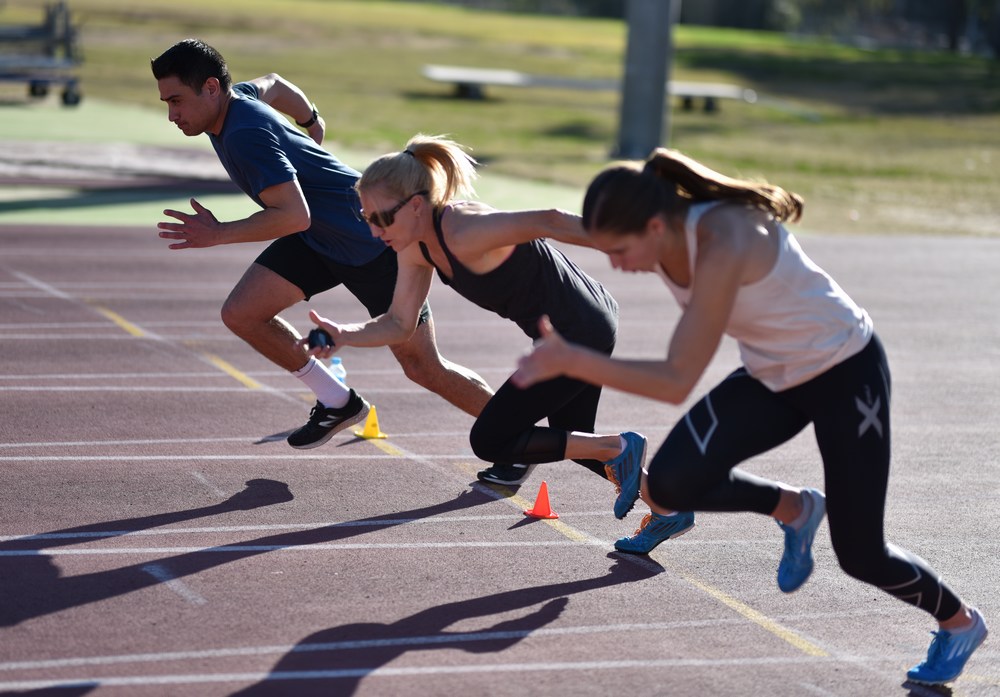
Although there is no optimum height for elite sprinting in either the male or female event, there is a range that would preclude very short or very tall athletes (Uth, 2005). Usain Bolt is the tallest elite sprinter at 196cm (Mackata & Mero, 2013). Within this range, shorter athletes have an advantage at the start, as the shorter swing thigh has an increased velocity and stride rate whereas taller athletes have an advantage in the maximum velocity phase due to a longer stride length.
Elite sprinters have a high mesomorphy, with greater relative muscle mass in the thighs (Bird, 2002), usually having longer legs relative to body height and have on average 70 – 80% Type II muscle fibres (Bosch & Klomp, 2005). This is logical considering that sprinting is composed of 5-10% aerobic ability and 90-95% anaerobic ability (Maughan & Gleeson, 2004).
Maintaining Talent
Although one may be born with all the anthropometrical, fibre type and somatotype requirements to become an elite sprinter, this may only maintain them through the junior ranks of athletics where early success, in most part, is driven by natural abilities and an advantageous physique (MacNamara, Button and Collins, 2010). Maintaining talent beyond this requires passion, motivation and dedication to training.

The high level of commitment required to sustain daily deliberate practice and physiological conditioning over many years, highlights the crucial role that psycho-behavioural characteristics will have on achieving elite performance (Abbott, 2006). Perseverance during challenging times, a desire to be the best, a willingness to work hard far beyond one’s comfort zone and a maturing athlete who takes responsibility for their own training and development and understands the sacrifices required to be the very best are characteristics of elite 100m sprinters (Dweck, 2007; MacNamara & Button, 2010).
Force Production is Critical (Morin et al.)
Research conducted on world class 100m performances discuss the mutually dependant parameters of stride length and stride frequency in determining speed (Young, 2007; Smiriotou et al. 2007; Morin et al. 2007; Majumdar & Robergs, 2011; Mackata & Mero, 2013; Clark et al. 2013; Morin et al. 2015). The important training factors arise out of how athletes increase either stride length or stride frequency, or both. Through much research, sport scientists agree the most important training factor contributing to an increase in stride length is force.
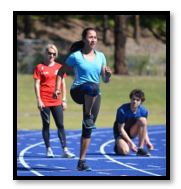
The physical capacity of an athlete to apply a summation of forces generated by the body into the ground, in the correct direction, to propel the athlete forward, seems most important. Weyard et al. (2000) “More force equals more speed”; Young (2007) “Magnitude and direction of force”; Smirniotou et al. (2007) “Force production is critical”; Morin et al.(2012) elite sprinters are “more effective at applying force”; Clark et al. (2013) “it is the magnitude and rate of ground force application”.
It is evident that the best sprinters apply more force in a shorter period of time, and that increased force applied in the right direction increases both stride length and stride frequency (Young, 2007).
Eradicate “Useless Mass”
Research on the fastest sprinters in the world show they have the capacity to produce extremely high ground reaction forces per kg of body weight (Morin. et al. 2015) Hence having a lean body mass and eliminating ‘useless’ mass is important. This sends a clear message to coaches that time spent in the development of efficient sprint mechanics and the development of relative strength and power is critical in achieving elite 100m sprint performance.

Sprinting at top speed is a highly coordinated activity and therefore the patterning over increasing distances in efficient sprint mechanics is crucial in training the neuromuscular system to maintain high excitations of muscular contractions for the duration of the race (Bird, 2002; Majumdar & Robergs, 2011).
Mechanics and Measurement
Morin et al. (2012) studied the important mechanics associated with 100m sprint success and determined three resulting factors: 1) having a velocity oriented “force-velocity” profile, 2) the capacity to apply ground reaction forces that deliver horizontal propulsion during acceleration and 3) a greater cadence due to a shorter ground contact time. The physical capacity to deliver each of these determinants at an elite level requires a finely tuned neuromuscular system, a large power to weight ratio and close to perfect mechanics.
The measurement of these performance factors is typically a faster finishing time for the event. However coaches should assess individual physical and psychological capacities to determine the strengths and weaknesses within an athlete’s development. This can be done by utilising the tests and tools in table A. These tests will assist in identifying key training factors for program planning.
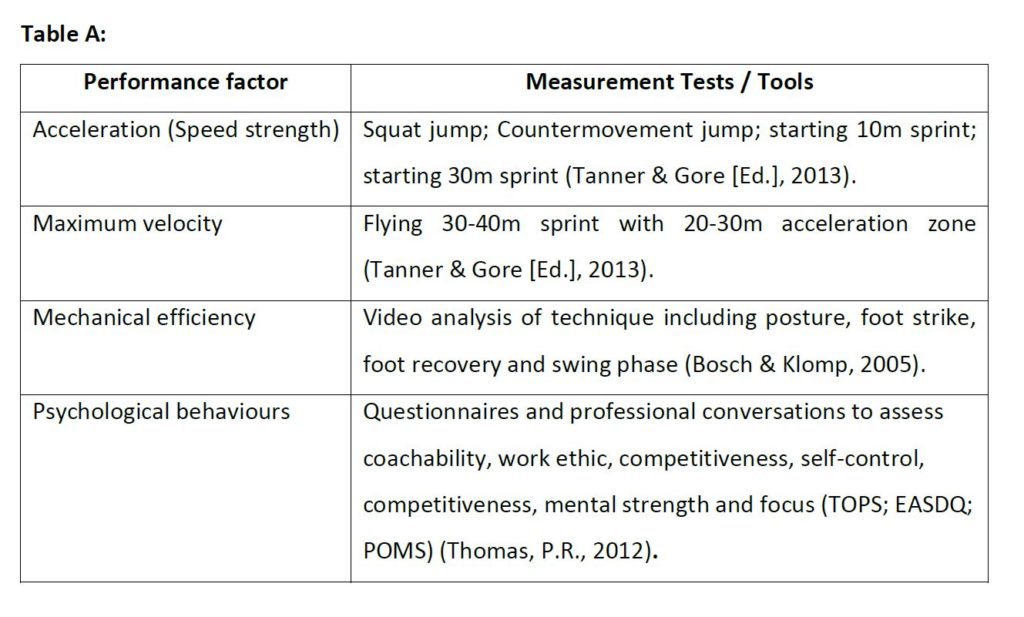
Event Requirements
The 100m sprint requires the athlete to have a quick reaction time to an auditory signal, explosive starting and acceleratory strength, high velocity stride frequency and the power to generate maximum force in the right direction to generate both vertical and horizontal propulsion (Bird, 2002; Young 2007).

This requires technical training in efficient sprint mechanics as well as physical training for speed, strength and power. Sprinters do not require any tactical decision making skills within the event, however having a detailed and specific warm up and call room routine could be seen as tactical in achieving desired race outcomes.
The psychological strength of the athlete is tested through the rigors of training and competition. As the athlete moves forward through the rounds (heats, semi-final and final), it is my experience that this has a significant role in the success of the athlete.
Psychological strength is required in the training leading up to a major event, in the call room, behind the start line, and in the maintenance of composure by staying relaxed through the event.
Conclusion:
Research that has been conducted on elite performances in the 100m sprint highlights the important training factors for success as: i) sprint mechanics, ii) strength, iii) power, iv) neuromuscular conditioning (speed and speed endurance), and v) psycho-behavioural tools.
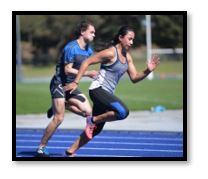
A final list of training factors is below:
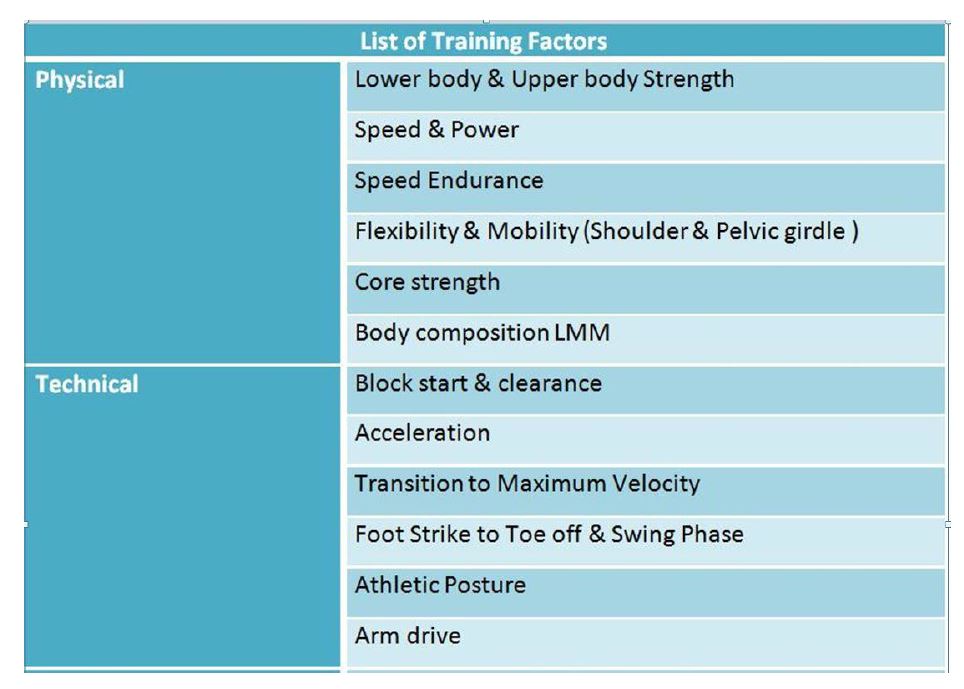

About the Author
Ranell Hobson: MS (Sp. Coach); BA (Sp. Sci & Coach.); Grad Dip (Edu -VET); CSCS (NSCA); ASCA L2 and ATFCA L3
Ranell is the Head Coach at the Academy of Sport Speed Australia.
Ranells specialty is Sport speed and Sprint mechanics, maximising athletic movement to decrease injury and improve overall player performance. Ranell is a multiple national sprint champion, Pan Pacific and Oceania masters multiple title winner and has competed at Masters World Athletics Championships all over the world for 15 years winning an individual silver medal in the 60m Indoor Championships in 2014 in Canada and a bronze medal in the 60m in Budapest in 2017 along with gold medals running for Australia in relay events. She was also a member of the then World Record holding 4 x 100m Australian team (W40+) in 2012. She works with youth to open age athletes and clubs across multiple sports and is an international presenter of Speed coaching workshops and Athlete Speed clinics.
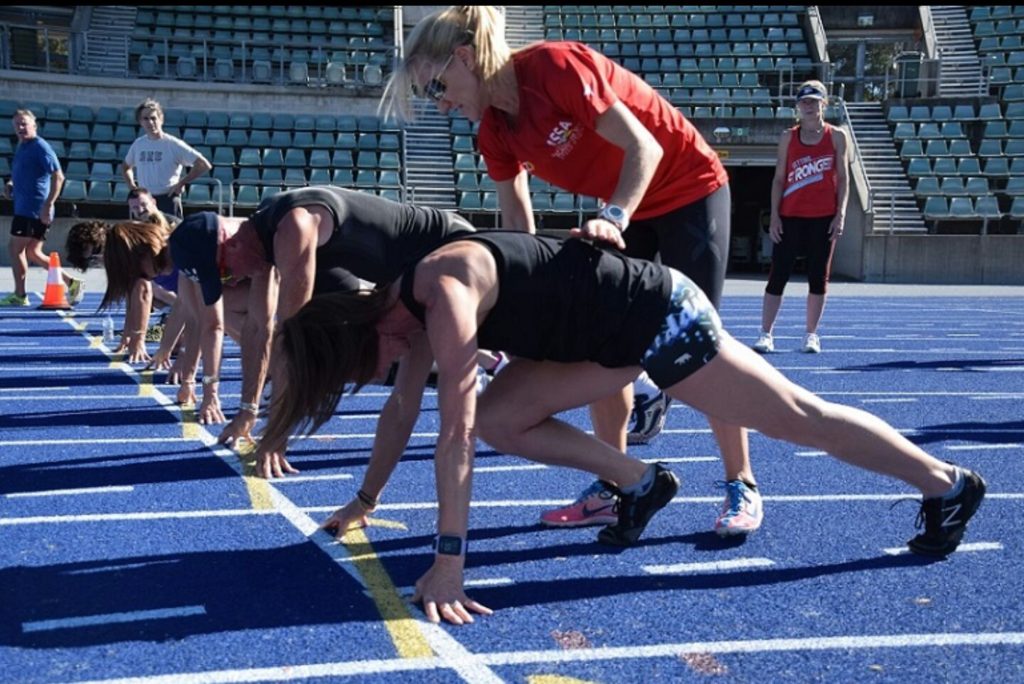
Reference list
Abbott, A.J. (2006) A multidimensional and dynamic approach to talent identification in sport. University of Edinburgh, UMI Dissertations Publishing.
Bird, S. (2002) Sports Performance Analysis: 100m Sprint. Retrieved from PT on the net website: http://www.ptonthenet.com/articles/sports-performance-analysis-100m-sprint- March 28, 2015.
Bosch, T. and Klomp, R. (2005). Running: Biomechanics and Exercise Physiology Applied in Practice. Philadelphia, PA: Elsevier.
Clark, K.P., Ryan, L. J., & Weyand, P.G. (2013). Human Sprint Running Mechanics: Do Right and Left Legs Apply Equal Ground Forces?. International Journal of Exercise Science: Conference Proceedings: Vol. 2: Iss. 5, Article 15.
Coh, M., Babic, V. & Mackata, K. (2010). Biomechanical, Neuromuscular and Methodical Aspects of Running Speed Development. Journal of Human Kinetics Vol 26 pp. 73-81.
Dweck. C.S (2007) Self Theories the mindset of a champion. In Morris, T., Terry, P., Gordon, S. Sport and Exercise Psychology: International Perspectives; Fitness Information Technology
Mackata, K. & Mero, A. (2013). A Kinematics Analysis of the Three Best 100m Performances Ever. Journal of Human Kinetics. Vol 36 pp.149-160.
MacNamara, A., Button, A. and Collins, D. (2010) The Role of Psychological Characteristics in Facilitating the Pathway to Elite Performance. Part 1: Identifying Mental Skills and Behaviours. The Sport Psychologist. V24, 1:52-73.
MacNamara, A., Button, A. and Collins, D. (2010) The Role of Psychological Characteristics in
Facilitating the Pathway to Elite Performance. Part 2: Examining environmental and Stage-Related Differences in Skills and Behaviours. The Sport Psychologist. V24(1) pp.74-96.
Majumdar, A.S., & Robergs, R.A. (2011). The Science of Speed: Determinants of Performance in the 100m Sprint. International Journal of Sports Science and Coaching. Vol 6 (3) pp479 – 493.
Maughan, G. and Gleeson, M. (2004). The Biochemical Basis of Sports Performance. New York, NY: Oxford University Press.
Morin, J., Slawinski, J., Dorel, S., Saez de villareal, E., Couturier, A., Samozino, P., Brughelli, M. & Rabita, G. (2015) Acceleration capability in elite sprinters and ground impulse: Push more, brake less? Journal of Biomechanics V48(12) pp.3149 – 3154 doi:10.1016/j.jbiomech.2015.07.009
Morin, J., Bourdin, M., Edouard, P. et al. (2012) European Journal of Applied Physiology V12(11) pp.3921-3930 doi:10.1007/s00421-012-2379-8
Smirniotou, A., Katsikas, C., Paradisis, P., Zacharogiannis, E. & Tziortzis, S. (2008) Strength-power parameters as predictors of sprinting performance. Journal of Sports Medicine and Physical Fitness. Vol 48 pp. 447-454.
Tanner, R.K. and Gore, C. (Ed.). (2013). Physiological Tests for Elite Athletes. 2nd Edition. Australian Institute of Sport. Human Kinetics.
Thomas, P.R. (2012) Using psychological tests to enhance skills in sport and performing arts. In Psych (December). Australian Psychological Society.
Uth, N (2005) Anthropometric comparison of world class sprinters and normal populations Department of Sport Science, University of Aarhus N, Denmark.
Weyand, P. G., Sternlight, D. B., Bellizzi, M. J., & Wright, S. (2000). Faster top running speeds are achieved with greater ground forces not more rapid leg movements. Journal of applied physiology, 89(5), 1991-1999.
Winkleman, N. (2009) A model of Periodisation: optimising performance and recovery in the elite 100m sprinter. UK Strength and Conditioning Association. 13: 14-18.
Winkleman, N. (2013) Elite speed development workshop. ASCA 2013 International conference on Applied Strength and Conditioning. Melbourne Australia.
Young, M. (2007). Maximal velocity sprint mechanics. Track Coach, 179, 5723-5729.
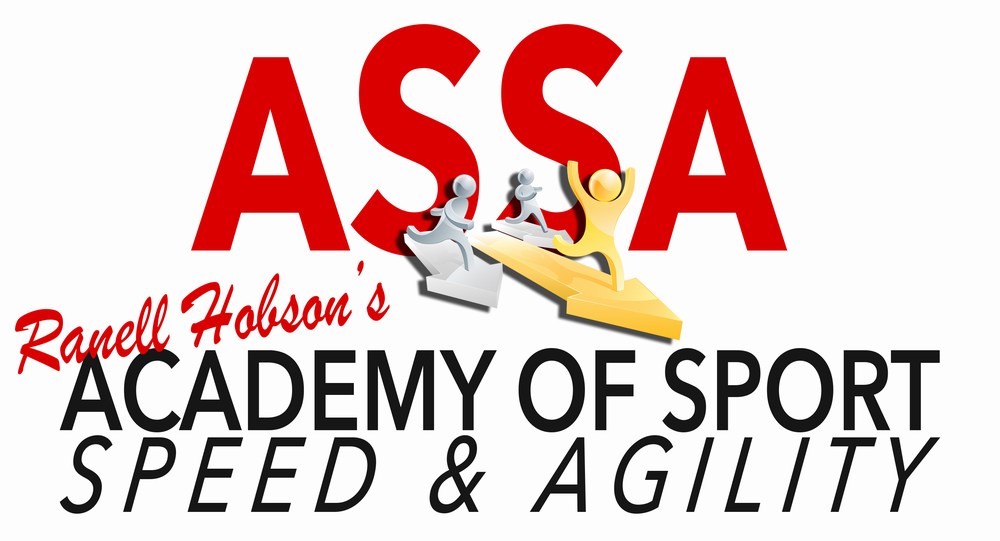
With havin so much written content do you ever run into any issues of plagorism or copyright violation? My site has a lot of exclusive content I’ve either written myself or outsourced but it looks like a lot of it is popping it up all over the internet without my permission. Do you know any solutions to help prevent content from being stolen? I’d truly appreciate it.
https://waterfallmagazine.com
What’s Happening i’m new to this, I stumbled upon this I have discovered It absolutely useful and it has helped me out loads.
I hope to contribute & help other users like its aided me.
Great job.